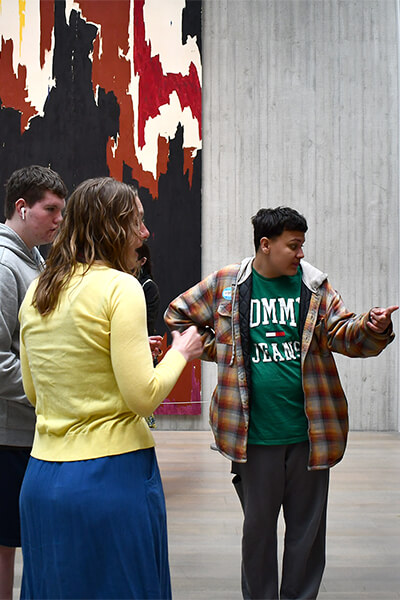Art and Ideas
Big Ideas:
- I belong in creative spaces that allow me to be myself and connect with others.
- I can be creative. Creativity looks unique to each person.
- Art can support me in the lifelong effort of learning about myself and others.
Essential Questions:
- What does belonging feel like?
- How do I exist in my communities?
- What is creativity? In what ways am I creative?
- Who am I?
- How does learning about myself shift over time?
Learning Targets:
- I can be myself.
- I can connect with my communities.
- I can decide what creativity means to me.
- My ideas are important. I can share them with others.
- I can observe and listen to other perspectives.
What will we do?
- Transition into the Museum and introduction to the experience.
- Divide into small groups and build community with educators.
- Receive a sketchbook to use during the visit and take home.
- Participate in two mini-workshops to look, respond, play, and express our ideas. Workshop themes include:
- Looking Closely: Practice close observation skills, form opinions and explain your thinking.
- Exploring Abstraction: Uncover the ways Clyfford Still experimented with abstraction.
- Investigating Identity: Use art as a tool to reflect on your identity and experiences.
- Connecting to Context: Put Still’s life and work in context with historical events, biography, and times of change.
- Responding Creatively: Be inspired by Still’s work to create your own creative response through visual art, movement/drama, and writing.
- Playing with Materials: Experiment with materials to express ideas and emotions.
- In all experiences, students will form and share their interpretations, listen and respond to others’ ideas, write and draw to learn and reflect, and collaborate with classmates.
- Debrief and transition out of the Museum.
Connections to Academic Standards:
Visiting the Clyfford Still Museum addresses multiple standards for the State of Colorado, Core Standards, and CASEL Social-Emotional Learning Framework. In a single Museum visit, students demonstrate essential skills, read, write, and communicate, build awareness of self and others, and participate in the iterative process of making, critiquing, and reflecting.
- Colorado Essential Skills:
- Creativity/Innovation
- Risk Taking
- Self-Awareness
- Initiative/Self-Direction
- Personal Responsibility
- Adaptability/Flexibility
- Perseverance/Resilience
- Collaboration
- Civic Engagement
- Character
- Self-Advocacy
- Leadership
- Colorado Academic Standards in Reading, Writing, and Communicating:
- Oral Expression and Listening
- Reading for All Purposes
- Writing and Composition
- Research Inquiry and Design
- Colorado Academic Standards in Social Studies
- History (Art and Context mini-workshop)
- Common Core State Standards:
- CCSS.ELA-LITERACY.CCRA.R.1
- CCSS.ELA-LITERACY.CCRA.R.6
- CCSS.ELA-LITERACY.CCRA.W.3
- CCSS.ELA-LITERACY.CCRA.SL.1
- CCSS.ELA-LITERACY.CCRA.SL.3
- CCSS.ELA-LITERACY.CCRA.L.6
- Colorado Academic Standards in Visual Arts:
- Observe and Learn to Comprehend
- Envision and Critique to Reflect
- Invent and Discover to Create
- Relate and Connect to Transfer
- National Core Arts Standards:
- Anchor Standard 1. Generate and conceptualize artistic ideas and work.
- Anchor Standard 2. Organize and develop artistic ideas and work
- Anchor Standard 3. Refine and complete artistic work
- Anchor Standard 4. Select, analyze, and interpret artistic work for presentation
- Anchor Standard 6. Convey meaning through the presentation of artistic work
- Anchor Standard 7. Perceive and analyze artistic work
- Anchor Standard 8. Interpret intent and meaning in artistic work.
- Anchor Standard 9. Apply criteria to evaluate artistic work.
- Anchor Standard 10. Synthesize and relate knowledge and personal experiences to make art.
- Anchor Standard 11. Relate artistic ideas and works with societal, cultural, and historical context
- to deepen understanding.
- CASEL Social Emotional Learning Framework:
- Self-Awareness
- Self-Management
- Social Awareness
- Relationship Skills
- Responsible Decision Making


